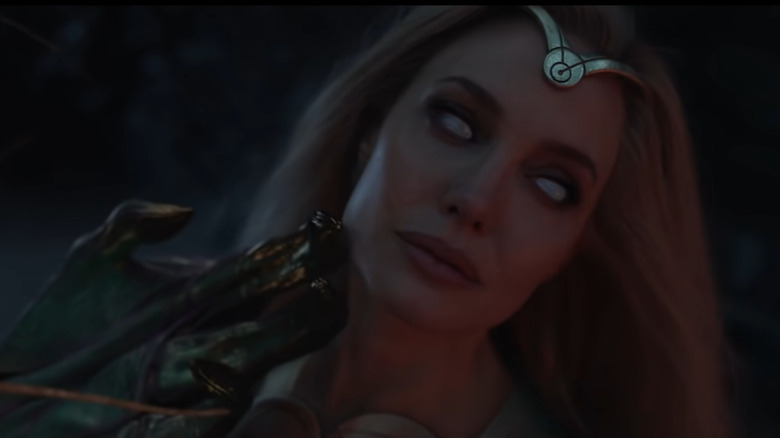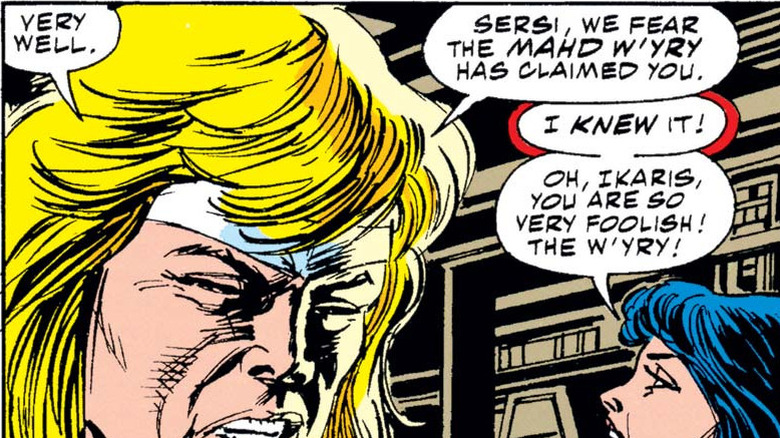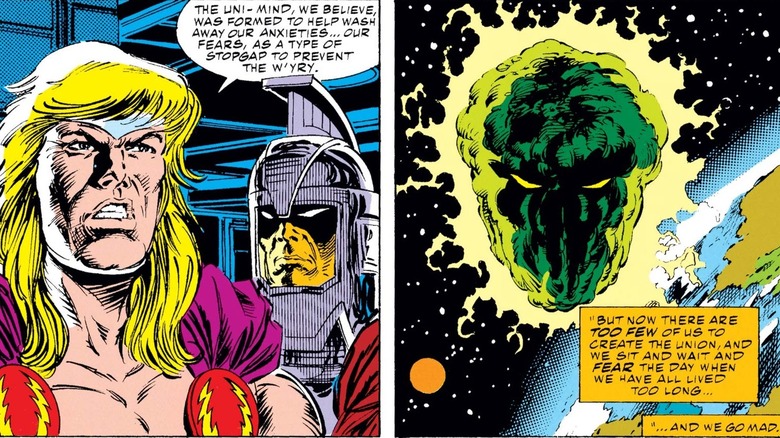Thena's Mahd W'yry Illness In Eternals Explained
"Eternals," the latest chapter in the Marvel Cinematic Universe, has finally emerged in theaters after a significant hiatus (much like the Eternals themselves). It tells the story of a series of vastly powerful beings created by the space-god Celestials to protect populations around the universe from Deviants, powerful and rapidly evolving apex predators. The film posits that Eternals had lived among humanity for millennia, being the source of many myths (Gilgamesh and Athena, anyone?) and technological advancements. Eternals are long-lived (and with a name like Eternals, wouldn't it be weird if they weren't?), serving the dictates of their Celestial masters over potentially millions of years.
For all their power and long-lived attributes, however, this longevity comes at a cost — a unique dementia-like illness called mahd w'yry, sometimes known to comic readers as "Eternal madness." In effect, the sheer volume of Eternals' memories over time can come to overwhelm their mind, causing them to forget exactly when they are and divorcing them from present reality. In the film, it's an illness suffered by the Eternal Thena (played by Angelina Jolie) that plays a pivotal role in her character arc.
We're going to break down this unique character affliction, how it affects Thena and the Eternals, and its comic book precedents.
W'yry is the Head That is Eternal
In comic lore, Eternals (first appearance in "Eternals" #1, July 1976) aren't created by Celestials ex nihilo, but rather are the product of Celestials' experimentations on humanity. They emerged a million years ago when Celestials arrived on Earth and experimented on early humanity to produce both the Eternals and the Deviants, the latter possessing power alongside genetic instability. Eternals are imbued with cosmic energy, resulting in a vast array of unique powers like superhuman strength, flight, the ability to create force blasts, illusions, weaponized energy, to transmute matter and energy — if it's powerful and can be done, it's a possible Eternal power. In addition to their ordinary longevity, Eternals can be restored to life upon destruction and essentially regenerated via "the Machine", the Celestial technology that creates the Eternals. Each group of eternals has a Prime Eternal whose powers can be enhanced by the collective creating a Uni-Mind, in essence a psychic meta-Eternal entity that has the powers of all the Eternals creating it.
With all these immense powers, they're subject to the aforementioned unique condition mahd wy'ry as a consequence of their immortality. (Yes, the burden of memory makes them mad and weary, and yes "mad weary" is how the condition is pronounced). In the comics, mahd w'yry is explained as a Celestial mistake (in "Avengers" #361), the product of imbuing human bodies with vast cosmic powers that last over millennia but with human minds and consciousnesses. It reportedly takes centuries to set in once it starts (though it can set in sooner) as the collective weight of experiences and memories take a toll on the Eternals' essentially human minds. The affliction can possibly be held at bay via the Eternals' abilities to share consciousness via the Uni-Mind or via their chosen life mate (in a process called "Gann Josin"), but as Ikaris explains in #361, the primary known cure is is an ancient "rite of cleansing"... the "molecular discorporation" of the increasingly mad Eternal. In effect, the afflicted Eternal's aforementioned death followed by their reconstruction via said "Machine."
Unlike the film, Thena isn't an eternal that suffers from the illness in comic lore. In the aforementioned issue #361, it's Sersi who suffers the disorder and faces destruction and reconstitution (which they ultimately don't do). It's also possible Sprite was affected by the disorder, provoking the idea to use the Dreaming Celestial to turn Sprite human and allow normal aging (instead of Sprite's perpetual childhood visage). It can hypothetically affect any Eternal, however, and the standard solution is a hard reboot of the afflicted Eternal.
You Mahd, Bro?
In the film (and unlike the comics), Eternals originate as an extraterrestrial presence created outside Earth, rather than being the products of Celestial human experimentation. Thus, mahd w'yry isn't caused by the accumulation of experience taking a toll on the human mind, but it is still described as a consequence of the Eternals' long lives. Also like the comics, the film's standard solution for the illness is a hard reset of that Eternal's life. Yes, the solution for the Eternal's illness in both cases is the tried-and-true advice to "turn if off and turn it back on again."
Another relevant difference between film and comics is that instead of Sersi or Sprite being affected by it (as in the comics), it is the warrior Thena who suffers the condition. In an interview with ScreenRant, producer Nate Moore explains Thena's situation in the film:
"She has a tragic story in our film in that she comes down with something called Mahd Wy'ry. If you guys are fans of comics, Mahd Wy'ry is something that can beset an Eternal. It's a version of dementia. Because of the amount of memories they have, they become unstuck in their own mind, so she starts to forget exactly when she is."
It hits some similar plot points as Sersi's comic struggle — a discussion over whether they should destroy and reconstruct her, for example, but in the film the protagonist Sersi isn't afflicted to any degree. Why Thena instead? They haven't made an exhaustive account of their storytelling decisions here, but it's definitely convenient to have perhaps the team's strongest warrior intermittently become a liability instead of an asset whenever it suits the story, and then be perfectly fine when she's needed again. Let's just chalk it up to a storytelling blank check.
With "Eternals" in theaters, you can see for yourself the effects of immortals getting mad weary ... that is, "mahd w'yry," yourself.


